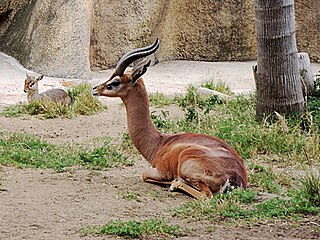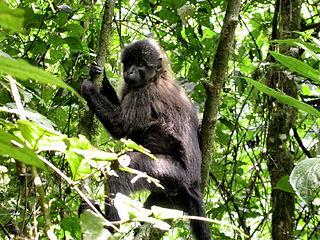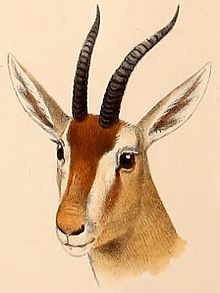
The term antelope refers to numerous extant or recently extinct species of the ruminant artiodactyl family Bovidae that are indigenous to most of Africa, India, the Middle East, Central Asia, and a small area of Eastern Europe. Antelopes do not form a monophyletic group, as some antelopes are more closely related to other bovid groups, like bovines, goats, and sheep, than to other antelopes.

The hartebeest, also known as kongoni or kaama, is an African antelope. It is the only member of the genus Alcelaphus. Eight subspecies have been described, including two sometimes considered to be independent species. A large antelope, the hartebeest stands just over 1 m at the shoulder, and has a typical head-and-body length of 200 to 250 cm. The weight ranges from 100 to 200 kg. It has a particularly elongated forehead and oddly-shaped horns, a short neck, and pointed ears. Its legs, which often have black markings, are unusually long. The coat is generally short and shiny. Coat colour varies by the subspecies, from the sandy brown of the western hartebeest to the chocolate brown of the Swayne's hartebeest. Both sexes of all subspecies have horns, with those of females being more slender. Horns can reach lengths of 45–70 cm (18–28 in). Apart from its long face, the large chest and the sharply sloping back differentiate the hartebeest from other antelopes. A conspicuous hump over the shoulders is due to the long dorsal processes of the vertebrae in this region.

The gerenuk, also known as the giraffe gazelle, is a long-necked, medium-sized antelope found in parts of East Africa. The sole member of the genus Litocranius, the gerenuk was first described by the naturalist Victor Brooke in 1879. It is characterised by its long, slender neck and limbs. The antelope is 80–105 centimetres tall, and weighs between 18 and 52 kilograms. Two types of colouration are clearly visible on the smooth coat: the reddish brown back or the "saddle", and the lighter flanks, fawn to buff. The horns, present only on males, are lyre-shaped. Curving backward then slightly forward, these measure 25–44 cm.

The black duiker, also known as tuba in Dyula, is a forest-dwelling duiker found in the southern parts of Sierra Leone, Liberia, Côte d'Ivoire, Ghana, Benin, and Nigeria.

The antilopines are even-toed ungulates belonging to the subfamily Antilopinae of the family Bovidae. The members of tribe Antilopini are often referred to as true antelopes, and include the gazelles, blackbucks, springboks, gerenuks, dibatags, and Central Asian gazelles. True antelopes occur in much of Africa and Asia, with the highest concentration of species occurring in East Africa in Sudan, Eritrea, Ethiopia, Somalia, Kenya, and Tanzania. The saiga inhabits Central and Western Asia, mostly in regions from the Tibetan Plateau and north of the Indian Subcontinent. The dwarf antelope species of tribe Neotragini live entirely in sub-Saharan Africa.

The rhim gazelle or rhim, also known as the slender-horned gazelle, African sand gazelle or Loder's gazelle, is a pale-coated gazelle with long slender horns and well adapted to desert life. It is considered an endangered species because fewer than 2500 are left in the wild. They are found in Algeria, Egypt, Tunisia and Libya, and possibly Chad, Mali, Niger, and Sudan.

Thomson's gazelle is one of the best known species of gazelles. It is named after explorer Joseph Thomson and is sometimes referred to as a "tommie". It is considered by some to be a subspecies of the red-fronted gazelle and was formerly considered a member of the genus Gazella within the subgenus Eudorcas, before Eudorcas was elevated to genus status.

The Barbary sheep, also known as aoudad is a species of caprine native to rocky mountains in North Africa. While this is the only species in genus Ammotragus, six subspecies have been described. Although it is rare in its native North Africa, it has been introduced to North America, southern Europe, and elsewhere. It is also known in the Berber language as waddan or arwi, and in former French territories as the moufflon.

The crested mangabeys are West African Old World monkeys belonging to the genus Lophocebus. They tend to have dark skin, eyelids that match their facial skin, and crests of hair on their heads. Another genus of mangabeys, Cercocebus, was once thought to be very closely related, so much so that all the species were placed in one genus. However, Lophocebus species are now understood to be more closely related to the baboons in genus Papio, while the Cercocebus species are more closely related to the mandrill. In 2006, the highland mangabey was moved from Lophocebus to a new genus, Rungwecebus.

Soemmerring's gazelle, also known as the Abyssinian mohr, is a gazelle species native to the Horn of Africa. The species was described and given its binomen by German physician Philipp Jakob Cretzschmar in 1828. Three subspecies are recognized. It is possibly no longer present in Sudan.

The red-fronted gazelle is widely but unevenly distributed gazelle across the middle of Africa from Senegal to northeastern Ethiopia. It is mainly resident in the Sahel zone, a narrow cross-Africa band south of the Sahara, where it prefers arid grasslands, wooded savannas and shrubby steppes.

The Atlas wild ass, also known as Algerian wild ass, is a purported extinct subspecies of the African wild ass that was once found across North Africa and parts of the Sahara.

The bubal hartebeest, also known as northern hartebeest or bubal antelope or simply bubal is the extinct nominal subspecies of hartebeest. It was formerly found north of the Saharan Desert. Other subspecies live currently in grasslands south of the Sahara, from Senegal in the west to Eritrea and Ethiopia in the east and down to central Tanzania. The red hartebeest and Lichtenstein's hartebeest, alternatively considered subspecies or sister species of the common hartebeest, are present in southern Africa.
Lemniscomys linulus, commonly known as the Senegal grass mouse or Senegal one-striped grass mouse, is a species of rodent in the family Muridae. It is found in Ivory Coast, Guinea, Mali, and Senegal and its natural habitat is dry savanna. At one time considered to be a subspecies of Lemniscomys griselda, it is now accepted as a species in its own right.

Phacochoerus is a genus in the family Suidae, commonly known as warthogs. They are pigs who live in open and semi-open habitats, even in quite arid regions, in sub-Saharan Africa. The two species were formerly considered conspecific under the scientific name Phacochoerus aethiopicus, but today this is limited to the desert warthog, while the best-known and most widespread species, the common warthog, is Phacochoerus africanus.

The Saharan striped polecat, also known as Saharan striped weasel and Libyan striped weasel, is a species of mammal in the family Mustelidae.

The Mongalla gazelle is a species of gazelle found in the floodplain and savanna of South Sudan. It was first described by British zoologist Walter Rothschild in 1903. The taxonomic status of the Mongalla gazelle is widely disputed. While some authorities consider it a full-fledged monotypic species in the genus Eudorcas, it is often considered a subspecies of Thomson's gazelle, while other authorities regard it as subspecies of the red-fronted gazelle.

Heuglin's gazelle, also known as the Eritrean gazelle, is a species of gazelle found east of the Nile River in Eritrea, Ethiopia and Sudan. It was considered a subspecies of the red-fronted gazelle or conspecific with Thomson's gazelle and Mongalla gazelle by some authors in the past. This small gazelle stands nearly 67 cm (26 in) at the shoulder and weighs between 15 and 35 kg. The coat is dark reddish brown with a dark reddish stripe on the flanks, except for the underparts and the rump which are white. Horns, present in both sexes, measure 15 to 35 cm in length.
Neoromicia grandidieri, known by the common names of Dobson's pipistrelle and yellow pipistrelle, is a species of vesper bat found in Africa. It was formerly in the genus Pipistrellus


















